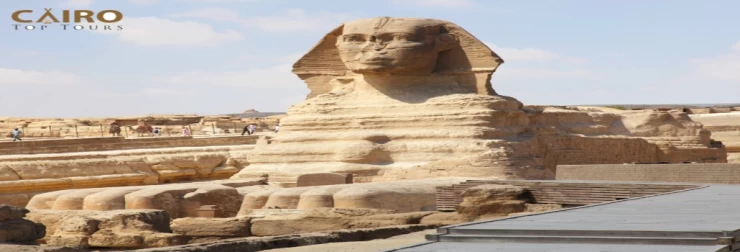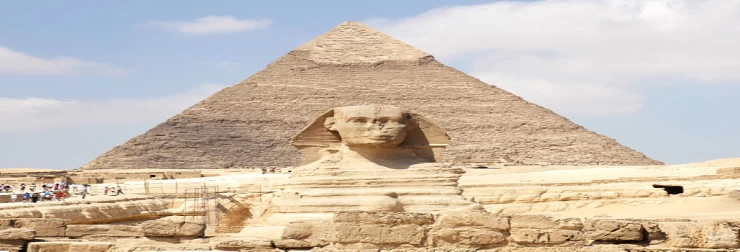
埃及金字塔 | 埃及金字塔
朱塞的阶梯金字塔
它也是埃及最古老的金字塔:阶梯金字塔的建造年代可以追溯到第三王朝初期,即内特雷希特国王统治时期(约公元前 2667-2648 年),当时的名字已经被称为 “乔瑟”。后来,这个名字被普遍使用,如今可能已成为埃及最著名的考古遗迹之一。因此,它构成了古埃及历史上殡葬古迹的一个重要节点;正因如此,它代表了石制建筑的一场革命,也给王室墓葬领域带来了变革。除了巨大的规模,它还是古埃及人建造的第一座金字塔,也是世界上已知的最古老的石头建筑。
倾斜的斯奈费卢金字塔
斯奈费卢斜面金字塔是世界上最大的斜面金字塔,已作为门夫古墓群的一部分被列入联合国教科文组织世界遗产名录。斜拉金字塔原高约 121 米,底部每边长约 188.1 米。它是一座倾斜的金字塔,第一个倾角为 55 度,高 49 米,52 米后的另一个倾角为 43 度。金字塔有两个入口:第一个入口位于北侧,高度为 12 米,入口处有一条长达 79.5 米的下行走廊,走廊通向一个带坡屋顶的十字大厅,然后通向一条不规则的走廊,从走廊右侧向上通向金字塔的西侧入口。左侧走廊通向一个未完工的墓室;其未完工的屋顶是用从黎巴嫩运来的雪松木桁架搭建的。金字塔曾有过几次发掘:第一次是公元 1839 年,英国人布兰奇和菲茨对金字塔内部进行了清理;第二次是公元 1894 年至 1895 年,德-摩根探险队来到这里。第一次科学考察是在这里进行的。
红色金字塔
红色金字塔是继南方一公里处的弧形金字塔和被称为迈杜姆金字塔的第三座金字塔之后,由斯内费卢国王建造的三座金字塔之一。红色金字塔是达舒尔金字塔中最高的一座;它之所以被称为 “红色”,是因为它的石头容易变成红色。它的表面覆盖着一层白色石灰石,这些石灰石来自现代开罗南部的图拉采石场,后来在中世纪被剥离出来,重新用于建筑。红金字塔是埃及第三大金字塔,仅次于吉萨的胡夫金字塔和哈夫雷金字塔。
胡夫金字塔
长期以来,人们一直认为胡夫金字塔是古代世界七大奇迹之一,也是用当地石灰石建造的大金字塔,但其实它的外层完全是由图拉采石场用驳船运来的价值极高的优质白色石灰石覆盖而成。这座金字塔包含三个墓室,一个开凿在下层岩石上,两个位于建筑本身内部的高处,这在契奥普斯金字塔和其他任何金字塔中都是独一无二的。这也是因为游客可以看到胡夫国王的石棺,因为上层的这个房间被称为国王的房间,可以通过一条走廊进入,走廊上有一个宏伟的分层天花板,被认为是古代建筑的杰作之一。
哈夫拉金字塔
吉萨的卡夫拉金字塔是现存最令人印象深刻的古代建筑之一。这座金字塔建于法老卡夫拉时期,约公元前 2520 年。它是吉萨建筑群中第二大的金字塔,但与吉萨大金字塔相比高度略低,塔顶高约 136 米(446 英尺)。
门卡乌尔金字塔
吉萨高原上的第三座金字塔是由卡夫列之子、胡夫之孙门考勒国王建造的,他在位时间约为公元前 2532 年至公元前 2503 年。由于基座面积较小,最初的金字塔只有 65 米高,因此门考尔的金字塔是吉萨三大金字塔中最小的一座。造成金字塔体积小的原因有很多,其中包括吉萨高原上剩余的面积很小,以及门考尔金字塔外壳所使用的材料,因为他的前辈们使用石灰石来包裹他们的金字塔,而门考尔使用的是从距离吉萨 800 多公里外的阿斯旺运来的花岗岩。
杰杰夫拉金字塔
金字塔尚未完工。完工后,它的大小将与吉萨第三大金字塔--门考尔金字塔相当。这座金字塔被认为是最美丽的金字塔,它的外表面由进口的抛光花岗岩和石灰石制成,上面有一个巨大的微型金字塔。人们还认为,由于它的未完工状态,在罗马帝国征服埃及后的统治时期,它基本上被拆除了。
关于埃及金字塔的信息
埃及金字塔代表着从旧王国到托勒密王朝晚期的王室陵墓,这一时期长达约 2700 年。此外,在第三王朝至第六王朝(公元前 2686 年至公元前 2325 年)期间,金字塔也接近建成。此外,它们并不是孤立的,而是一个由结构组成的建筑群。
古埃及人选择在尼罗河的西边建造金字塔,是因为他们认为西边象征着死者的世界--太阳在那里落下,所以他们把坟墓建在西边;而东边代表着生者的世界,太阳在那里升起,所以他们把城市建在那里。这并不是决定选址的唯一因素,但地势高低是一个先决条件。
Positioned at an elevation surrounded by sand hills, one can easily understand why the pyramids found in Egypt are one of the most recognizable structures quite literally in the whole world. It is perhaps impossible to get a person who has traveled, read, or even watched a documentary and not be captivated by these towering structures that have stood the test of time for centuries. Their beauty and how they were constructed leave no one indifferent and is the primary reason historians, regardless of age, travel to ancient countries. With that being said, let us go back in time to study the greatness of the pyramids in Egypt, why they matter historically, and what impact, if any, they made for future generations.
A Glimpse into Ancient Egypt’s Architectural Genius
From a historical perspective, the magnificence of the pyramids reveals the creativity and architectural skills of the ancient Egyptians. These great edifices, built as shrines for the kings and emperors to symbolize their godly power, display the heightened level of engineering, mathematics, and astronomy acquired by the Egyptians.
These pyramids were not simply built to contain and protect the preserved corpses of kings and queens. They were designed along the lines of doorways or rather turned off to be concerned with the interior, the beyond. The ancients believed that their kings would not only reign over them in this world but also in the next, and so the pyramids were constructed to provide fit accommodations for their wandering spirits. So too with the physical body of the pharaoh, riches, provisions, and ritual items were interred to assist the person’s transition to everlasting life.
The Great Pyramid of Khufu
Due to several centuries of exposure, the pyramid stands at only about 138 m in height, which is still considerable.
The Great Pyramid is estimated to have contained more than 2.3 million stone blocks, with several characters feasible weighing one hundred tons, and considering this, it could be said that the pyramid strategies are among the engineering marvels of the ancient world. Even how the Egyptians would have managed to cut, transport, and assemble the huge blocks remains a mystery—some say that ramps or even cranes had been employed, yet others say that only brute strength sufficed; others propose the use of intellect.
The Pyramid of Khafre
Khafre’s Pyramid, also known as the tomb of Khafre the Son of Pharaoh Khufu, is one of the many structures situated in the Giza plateau region. Even though Khafre's pyramid is shorter than his father's, he seems to dwarf his father’s pyramid because of its placement on higher ground and, more importantly, a large part of the upper part of the pyramid, which has the original smooth casing stones that have survived the weather elements, giving the impression of a much bigger structure. All the pyramids had this layer, made of glossy Tura limestone that was so well polished it was almost glass; hence all of them glittered in the sun.
In addition, the Pyramid of Khafre features the Great Sphinx of Giza, found at the front of the pyramid. The Great Sphinx, which possesses the head of a man and the body of a lion, is carved from a singular piece of limestone and is largely assumed to symbolize Khafre. This giant figure, which is positioned at the front of the pyramids, piques curiosity towards the Giza complex even more.
The Pyramid of Menkaure
Out of the three pyramids in Giza, the smallest is undoubtedly the Pyramid of Menkaure, erected for Khafre’s son, Pharaoh Menkaure. However, this pyramid stands out because part of its casing is made of granite instead of the common limestone used for most well-known pyramids. This material, coupled with the pitch and height of the pyramid, suggests that Menkaure had ambitions of being remembered with the other great kings of Egypt.
Although the Pyramids of Giza are perhaps the most well-known, they are by no means the only pyramids in Egypt. Pyramids were built throughout the Nile Valley at various stages of Egyptian history and in different architectural styles, as well as for different purposes.
The Pyramid of Djoser
The Pyramid of Djoser is considered to be one of the oldest pyramids ever made and can be located in the Saqqara region with its necropolis. This step-designed tomb was built for Pharaoh Djoser by his architect Imhotep, who is mostly regarded as one of the creators of all pyramids to come. Rather than a smooth-sided infinite tower, Djoser’s pyramid is made of six terraced levels with an interesting layered look. This was a great milestone in the age of building pyramids, and it is still one of the most frequent places in Egypt.
The Bent Pyramid and the Red Pyramid
Another well-known location for pyramids is Dahshur, which features the Bent and Red Pyramids, both constructed by Pharaoh Sneferu. The Bent Pyramid stands out due to its unique design since the angles of the sides bend in the middle of the pyramid. This shaped more than a simple pyramid, and it was probably because of some problems encountered while building the pyramid. Nevertheless, it was not much later that Sneferu attempted to build his second pyramid, now called the Red Pyramid, and this one was much more successful than the first, for it became the first true pyramidal structure on a smooth surface within the territory of Egypt.
The massive blocks were maneuvered using ramps, sleds, and some levers. But there are other theories regarding the construction of the great pyramids that are more advanced than this; for instance, aliens coming to earth and building the pyramids, but so-called ‘crazy’ theories are generally not accepted by scholars.
There have been new studies that have come up with such things as the discovery of the workers’ villages and the tools, which also assist in helping people understand the construction of the great pyramids much more than before. Evidence goes against the perception of slavery, for it appears that pyramid builders were given food and shelter, and their work was appreciated.
The geometric understanding of a pyramid, characterized by a wider base that tapers to a point at the top, was designed to represent the rays emitted by the sun as the dead pharaoh was believed to rise and join the sun god, Ra, in death. The position of the pyramids north and south of the equator as well as their alignment with the constellations embodies the Egyptians’ firm belief in the connection between the sky and the land of the living.
Inside the pyramids, spaces, and corridors were typically built with the purpose of housing the pharaoh’s body while also serving as a means to help the spirit cross over. The insides of many pyramids were embellished with inscriptions called Pyramid Texts that consisted of spells for helping the hereafter of the pharaoh. Even though most of the valuables and objects that were kept in these pyramids have been taken away or destroyed over the years, the pyramids themselves are forever embodiments of the Egyptian faith of existence after death.
The Legacy of the Pyramids
The pyramids of Egypt have had a lasting impact on the course of history, in as much as they can be compared to any other structure. The dimensions of the pyramids, their architectural intricacy, together with the enigma surrounding the periods of their construction have motivated several generations of humankind. In the present, those structures attract awe to innumerable people every year who want to see with their own eyes one of the most magnificent monuments created in ancient history.
Besides the appreciation of the pyramids as significant cultural and historical treasures, these structures have also become icons of human determination and creativity. Their position on the skyline of the desert of Egypt evokes memories of a culture that, many millennia ago, was capable of creating marvels that still amaze people today.


















